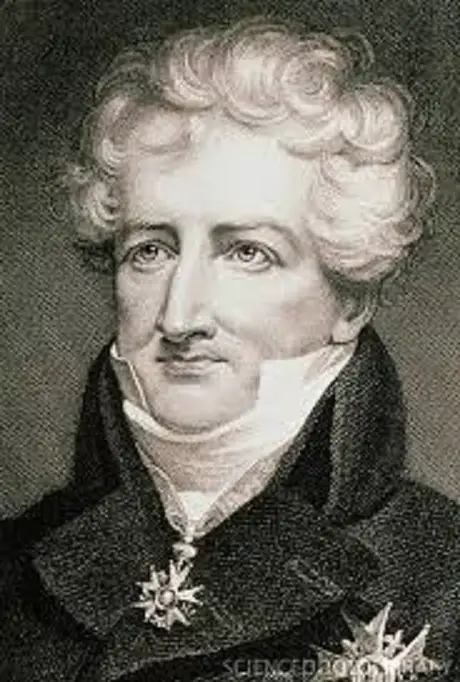George Cuvier (1769-1832) was a French Zoologist and biologist who made an immense contribution in various fields like paleontology, taxonomy and comparative anatomy.
He had one of the finest minds in history. He also was a chief spokesman in post-revolutionary for Science in France.

Short Biography of Cuvier
George Leopold Cuvier was born on August 1769 in Montbeliard of France to his father Jean George Cuvier and mother Anne Chatel. Cuvier studied at a school in Germany from 1784 to 1788. He then was a tutor for a family in Normandy that kept him away from the violence of the French revolution. Later in 1795, Cuvier was appointed as an assistant by Geoffroy Hilaire and in short duration, he took the position of professor of animal anatomy at National Museum of Natural History.
He was elected as a member of the anatomy and zoology department in the France Institute. Later in 1800, he was appointed as a Secretary for the Institute of the physical science and the professor of natural history at a college in France.
Cuvier made his significant contribution by being active for research scientist as well as for scientific educationalist and a bureaucrat. He had published his main works focusing on fossils, natural history, animal classification, comparative anatomy, and theoretical paleontology.
Cuvier was designated as a counselor in France in1808 for Napoleonic University. He then remained at the same position under three successive Kings of France. He was also a member of the Council of State from 1813 till his he rested in peace. He was appointed a vice president of the Ministry of the Interior in 1817 and in the following year he was a member of Academic of France. He was made a baron in 1820. Cuvier was then the chancellor of France University from 1821 to 1827. Cuvier then died due to cholera at age of 62 on May 1832 in Paris.
Facts about George Cuvier
Some of the Interesting facts about Cuvier are as follows”:
- Cuvier is one among the list of 72 celebrated personalities that has his name engraved on the Eiffel Tower in Paris. He is eight on the list on the North.
- Cuvier was the first scientist who published the work which identified a fossil as a flying reptile using his principle of correlation of parts. He called it as Pterodactyl.
- In 1817, Cuvier’s best work “The Animal Kingdom “was published which is basically a summary of the study of living species and fossils by Cuvier that also contained 300 drawings made by Cuvier himself.
George Cuvier and the “Living Mastodon”
Cuvier read his first paper at the National Institute in 1796 where he demonstrated that the bones of the mammoth are different than that of modern elephants. He researched that mammoths, African elephants and Indian elephants are three different species.
He also convinced that mammoths are now extinct as they cannot be hidden anywhere without knowledge of human because of their big size. Cuvier earned the nickname of “The Mammoth” for his research. He also recognized the fourth distinct and obsolete member of the elephant family and named him as “The Mastodon”.
Famous Quotes by George Cuvier
Many scientific quotes were given by Cuvier based on his works. Some of which are as below
- The observer listens to nature: the experimenter questions and forces her to reveal herself.
- It is my object, in the following work, to travel over ground which has as yet been little explored and to make my reader acquainted with a species of Remains, which, though absolutely necessary for understanding the history of the globe, have been hitherto almost uniformly neglected.
- All organs of an animal form a single system, the parts of which hang together, and act and react upon one another; and no modifications can appear in one part without bringing about corresponding modifications in all the rest.
- The appearance of the bones of quadrupeds, especially those of complete bodies in the strata, tells us either that the layer itself which carries them was in earlier times dry land or that dry land was at least formed in the immediate area.
- My object will be, first, to show by what connections the history of the fossil bones of land animals is linked to the theory of the earth and why they have particular importance in this respect.
- Genius and science have burst the limits of space, and few observations, explained by just reasoning, have unveiled the mechanism of the universe. Would it not also be glorious for man to burst the limits of time, and, by a few observations, to ascertain the history of this world and the series of events which preceded the birth of the human race?
- Moreover, it thus follows that not a great deal of time was needed for the large animals of the three major parts of the world to become known to the people who spent time on the coasts of those regions.
Frederic Cuvier
George Frederic Cuvier (1773-1838) was the younger brother of Georges Cuvier and he was also Paleontologist and a French zoologist. In 1835 he was elected as a foreign member of the Royal Society.
Frederic was referred in the Charles Darwin’s “On the Origin of Species”. In 1807 he became the first scientist to quote the term “hereditary” and then in 1812 the term “heredity” with reference to biological context. Based on this animal behavior study, he used both these terms to promote the acquired characteristic inheritance. He also like George Cuvier declined the species transmutation.
Cuvier’s influence on Darwin
For Darwin’s theory of evolution, the groundwork was provided by Cuvier’s work on the revolutionary creation of new species and animal extinction. He also proposed that after every adversity, new species are created. In Darwin’s Theory of natural selection and survival of the fittest, Cuvier’s extinction work was integrated.